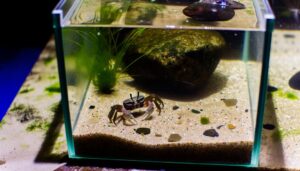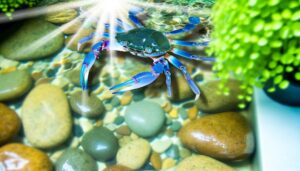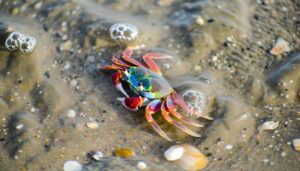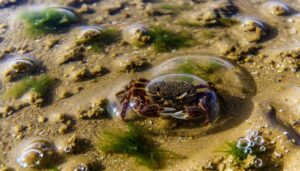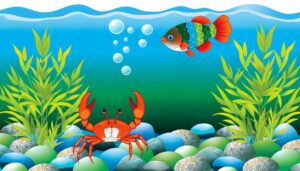Do Fiddler Crabs Need Air?
Fiddler crabs thrive in well-maintained habitats where water quality parameters are within best-fit ranges. Effective filtration systems are vital, as they help reduce harmful compounds such as ammonia and nitrites, which can be lethal even at low concentrations.
Filters aid in oxygenation, pollutant reduction, and maintaining stable brackish water conditions, with specific gravity levels between 15 to 30 ppt. Natural filtration methods, like incorporating live plants and specific substrates, also support a balanced ecosystem.
Regular monitoring and partial water changes complement the filtration system, ensuring a healthy environment. Understanding the significance of these measures lays the groundwork for ideal fiddler crab care.

Key Takeaways
- Filters help maintain stable water quality, reducing pollutants and enhancing oxygenation.
- Proper filtration minimizes the risk of lethal ammonia and nitrite concentrations.
- Filters aid in maintaining ideal salinity, pH levels, and temperature for fiddler crabs.
- Effective filtration supports a balanced ecosystem, promoting overall health and reducing disease susceptibility.
- Regular filtration reduces the need for frequent, extensive manual cleaning and water changes.
Importance of Water Quality
Maintaining ideal water quality is crucial for the health and survival of fiddler crabs. It directly influences their physiological processes and overall well-being. Best water quality parameters include salinity levels of 15-25 ppt, pH levels between 7.5-8.5, and temperatures ranging from 24-28°C.
Deviations from these conditions can lead to osmoregulatory stress, impaired molting, and increased susceptibility to pathogens. Research indicates that ammonia concentrations above 0.1 ppm and nitrite levels exceeding 0.25 ppm can be lethal.
Regular monitoring and maintenance of these parameters are essential. Implementing a quality filtration system aids in the removal of organic waste and toxins, ensuring the stability of the aquatic environment. This fosters a habitat conducive to the crabs' thriving.
Fiddler Crab Habitat Basics
A well-structured habitat for fiddler crabs incorporates both terrestrial and aquatic elements to mimic their natural environment, facilitating their physiological and behavioral needs.
The terrestrial component should provide ample space for burrowing, an essential activity for shelter and reproduction. A sandy substrate is recommended due to its ease of manipulation by the crabs.
The aquatic section should maintain brackish water conditions, reflecting the intertidal zones these crabs typically inhabit. Salinity levels should be monitored and kept between 1.005 to 1.015 specific gravity.
Additionally, the water depth should allow the crabs to submerge completely yet not be so deep as to inhibit their access to the land. Proper temperature regulation, ideally between 75-85°F, is vital for their metabolic and immune functions.
Natural Filtration Methods
Natural filtration methods are essential for maintaining peak water quality for fiddler crabs. The incorporation of live plants is crucial for oxygenating the water and absorbing harmful nitrates and phosphates. Sand serves as an effective substrate, promoting the growth of beneficial bacteria that break down organic waste. This enhances the overall filtration efficiency.
These methods work together to create a balanced ecosystem that supports the health and well-being of fiddler crabs.
Live Plants Benefits
Incorporating live plants into a fiddler crab habitat greatly enhances water quality through natural filtration mechanisms. Plants absorb harmful nitrates and waste products. Aquatic vegetation such as Java moss (Taxiphyllum barbieri) and Anubias species efficiently assimilate nitrogenous compounds, reducing the toxic ammonia levels that can accumulate in enclosed systems.
The root systems of these plants also stabilize substrate, preventing the resuspension of organic particulates which can degrade water clarity. Additionally, the photosynthetic activity of live plants contributes to oxygenation, crucial for maintaining aerobic conditions essential for both the crabs and beneficial bacterial colonies.
Empirical studies have shown that aquariums with live plants exhibit notably lower concentrations of dissolved pollutants, underscoring their role in a balanced and healthy fiddler crab ecosystem.
Sand's Filtration Role
Using sand as a substrate in fiddler crab habitats greatly enhances natural filtration by providing a large surface area for beneficial bacteria colonization, which is essential for the breakdown of organic waste and nitrogenous compounds. Sand particles create a microenvironment conducive to nitrifying and denitrifying bacteria, facilitating the nitrogen cycle. This process mitigates ammonia toxicity, enhancing water quality and promoting crab health.
| Parameter | Sand Substrate | No Sand Substrate |
|---|---|---|
| Surface Area | High | Low |
| Bacterial Colonization | Extensive | Limited |
| Ammonia Levels | Reduced | Elevated |
| Water Quality | Improved | Degraded |
Empirical evidence supports that utilizing sand not only mimics natural conditions but also significantly contributes to maintaining a stable aquatic ecosystem.
Types of Aquarium Filters
Aquarium filters can be broadly categorized into three primary types: mechanical, biological, and chemical. Each serves a distinct role in maintaining water quality, which is critical for the health of aquatic species like fiddler crabs.
Mechanical Filters: These filters physically remove debris and particulate matter using media such as sponges or filter floss.
Biological Filters: Utilizing beneficial bacteria, these filters break down harmful ammonia and nitrite through nitrification, converting them into less toxic nitrate.
Chemical Filters: Activated carbon or specialized resins remove dissolved organic compounds, metals, and impurities via adsorption.
Hybrid Systems: Combining elements of all three types, these systems provide thorough filtration, addressing various water quality parameters simultaneously.
Understanding these filter types is essential for maintaining ideal aquatic environments.
Benefits of Using a Filter
Ensuring best water quality, filters play an essential role in removing pollutants and maintaining the ecological balance necessary for the health and well-being of fiddler crabs. Filters effectively reduce ammonia, nitrites, and nitrates, which are toxic to fiddler crabs, thereby minimizing the risk of disease. Additionally, filters enhance oxygenation levels, vital for aerobic respiration. By maintaining consistent water parameters, filters also prevent environmental stress, which can lead to behavioral changes and decreased survival rates.
| Benefit | Description | Importance for Fiddler Crabs |
|---|---|---|
| Pollutant Removal | Reduces ammonia, nitrites, nitrates | Minimizes disease risk |
| Enhanced Oxygenation | Increases dissolved oxygen levels | Supports aerobic respiration |
| Stable Water Quality | Maintains consistent water parameters | Prevents environmental stress |
Ultimately, consistent filtration contributes to a stable, healthy habitat, promoting the overall well-being of fiddler crabs.
Potential Drawbacks of Filters
Despite their numerous advantages, filters for fiddler crab habitats can present several potential drawbacks that warrant careful consideration.
- Mechanical filters can create too much water flow, disrupting the crabs' natural behaviors.
- Specific chemical filters may unintentionally eliminate essential trace elements needed for the crabs' health.
- Biological filters could host pathogens if not properly maintained, posing a risk of disease.
- The installation and maintenance of filters can be labor-intensive and costly, requiring regular monitoring to ensure ideal conditions.
These factors necessitate a balanced approach to habitat management.
Alternative Maintenance Methods
In the absence of mechanical filtration, regular water changes and substrate cleaning methods can effectively maintain water quality in fiddler crab habitats. Empirical studies indicate that frequent water changes help to mitigate the accumulation of harmful ammonia and nitrites, thereby promoting a stable aquatic environment.
Additionally, targeted substrate cleaning can remove detritus and uneaten food, reducing the risk of bacterial proliferation and maintaining overall ecosystem health.
Regular Water Changes
Regular water changes are a critical component of maintaining ideal water quality for fiddler crabs, as they help to remove waste products, excess nutrients, and harmful chemicals that accumulate over time. Implementing a consistent water change regimen can greatly enhance the overall health and longevity of fiddler crabs.
This procedure involves:
- Frequency: Conducting partial water changes weekly or bi-weekly.
- Volume: Replacing 20-30% of the aquarium water each time.
- Temperature: Ensuring the new water matches the tank's temperature to avoid thermal shock.
- Dechlorination: Using a water conditioner to neutralize chlorine and chloramines.
These steps collectively help to maintain stable water parameters, promoting a thriving environment for fiddler crabs without the need for complex filtration systems.
Substrate Cleaning Methods
Effective substrate cleaning methods are vital for preventing the accumulation of debris and harmful anaerobic conditions in fiddler crab habitats. Manual siphoning is a widely recommended technique, utilizing a siphon tube to remove debris-laden water from the substrate surface.
Periodic agitation of the substrate can also dislodge deeply rooted organic matter, allowing for more efficient removal. Another approach involves introducing scavengers like snails to naturally consume detritus. Moreover, using a turkey baster to target specific areas can improve accuracy in cleaning.
Regularly monitoring substrate conditions with chemical test kits for ammonia and nitrite levels guarantees that the environment remains non-toxic. These evidence-based practices collectively help maintain a healthy, balanced ecosystem for fiddler crabs without requiring complex filtration systems.
Balancing Salinity Levels
Maintaining optimal salinity levels is crucial for the physiological well-being and osmoregulatory effectiveness of fiddler crabs. Inaccurate salinity can result in stress, reduced metabolic function, and compromised mobility.
Studies show that fiddler crabs flourish in brackish water, with salinity levels ranging from 15 to 30 parts per thousand (ppt).
To establish and sustain these conditions, follow these steps:
- Regularly Measure Salinity: Utilize a refractometer or hydrometer for precise measurements.
- Utilize Marine Salt: Incorporate marine salt into freshwater to attain the desired salinity range.
- Monitor Evaporation: Replenish the tank with freshwater to offset evaporation and avoid sudden changes in salinity.
- Perform Partial Water Changes: Replace a portion of the tank water weekly to uphold consistent salinity and overall water quality.
These practices guarantee an optimal setting for fiddler crabs.
Managing Waste Buildup
Addressing waste buildup in fiddler crab habitats is essential for maintaining water quality and preventing harmful ammonia and nitrate concentrations. Organic waste, such as uneaten food and feces, can decompose, leading to elevated levels of toxic compounds. Implementing a robust waste management strategy is critical. Regular substrate cleaning, water changes, and the use of biological filters can mitigate these risks. Research indicates that without adequate filtration, ammonia levels can exceed safe thresholds within days, stressing the crabs and compromising their health.
| Waste Management Practice | Impact on Water Quality |
|---|---|
| Regular substrate cleaning | Reduces organic matter buildup |
| Water changes | Dilutes harmful compounds |
| Biological filters | Promotes nitrification process |
| Controlled feeding | Minimizes excess food decay |
| Monitoring water parameters | Ensures timely interventions |
Effective waste management is crucial for the thriving of fiddler crabs in captivity.
Signs of Poor Water Quality
Observable signs of poor water quality in fiddler crab habitats include heightened cloudiness, unusual crab conduct like sluggishness or irregular motions, and the existence of unpleasant scents emanating from the water. These signals are crucial as they can indicate harmful changes in the aquatic environment, potentially resulting in health problems for the crabs.
Key observable symptoms include:
- Heightened Cloudiness: Murky water hinders light penetration, impacting photosynthesis and the habitat's overall well-being.
- Unusual Behavior: Sluggishness or irregular movements imply stress or toxicity.
- Unpleasant Scents: Off-putting aromas often indicate the presence of decaying organic material or harmful bacteria.
- Algae Overgrowth: Excessive algae can reduce oxygen levels and disrupt the ecosystem.
Understanding these indicators is vital for maintaining ideal conditions for fiddler crabs.
Choosing the Right Filter
Selecting the appropriate filtration system is essential for ensuring the best possible health and longevity of fiddler crabs in captivity. An ideal filter should provide mechanical, chemical, and biological filtration. Mechanical filtration removes particulate matter, preventing detritus buildup.
Chemical filtration, typically using activated carbon, purifies water by adsorbing toxins and dissolved organic compounds. Biological filtration is necessary for nitrification, wherein beneficial bacteria convert harmful ammonia into less toxic nitrate.
A hang-on-back (HOB) filter or a sponge filter is generally recommended, as they efficiently handle all three filtration types. It is vital to select a filter rated for at least twice the tank's volume to guarantee adequate water turnover.
Proper filtration maintains water quality, thereby promoting the crabs' overall well-being.
Regular Tank Cleaning Tips
Proper maintenance of a fiddler crab's habitat is crucial for ensuring ideal health and longevity.
It is essential to spot clean daily debris to prevent the accumulation of harmful waste, which can lead to toxic ammonia levels.
Additionally, regular water changes are necessary to maintain water quality parameters, such as pH and salinity, that are beneficial to the well-being of fiddler crabs.
Spot Clean Daily Debris
To maintain best water quality and safeguard the health of fiddler crabs, it is important to spot clean daily debris from the tank using a fine mesh net or siphon. This practice helps in preventing the accumulation of detritus and uneaten food, which can degrade water quality and foster harmful bacterial growth.
Spot cleaning involves:
- Gently removing uneaten food particles: Make sure that all leftover food is collected to avoid decomposition.
- Extracting waste matter: Fiddler crab excrement should be regularly removed to prevent ammonia accumulation.
- Clearing plant debris: Dead plant leaves or fragments should be extracted to keep the habitat clean.
- Checking and cleaning substrate: Regularly stir and clean the substrate to release trapped organic matter.
These steps are crucial in maintaining a stable and healthy environment for your fiddler crabs.
Change Water Regularly
Regular water changes are necessary for maintaining the best water chemistry parameters necessary for the health and well-being of fiddler crabs. These decapod crustaceans are sensitive to fluctuations in ammonia, nitrites, and nitrates, substances that can accumulate rapidly in a closed aquatic system.
Weekly partial water changes, typically 10-20% of the tank volume, help mitigate these harmful compounds and replenish essential minerals. Using dechlorinated water during this process is important to prevent chlorine toxicity.
Monitoring pH and salinity levels, specifically maintaining a brackish environment, is vital since fiddler crabs thrive in slightly saline conditions. Consistent water changes not only reduce the risk of disease but also support the best molting and overall physiological functions.
Maintaining a Healthy Environment
Optimizing a healthy environment for fiddler crabs involves careful regulation of water quality, encompassing parameters such as salinity, pH levels, and temperature. These elements are essential for their physiological well-being and behavioral activities.
To maintain ideal conditions, consider the following:
- Salinity: Maintain brackish water with a specific gravity between 1.005 and 1.015.
- pH Levels: Ensure the pH remains in the range of 7.5 to 8.5 to support proper metabolic functions.
- Temperature: Keep the water temperature steady between 75°F to 85°F to replicate their natural habitat.
- Filtration: Utilize a reliable filtration system to remove waste and prevent the buildup of harmful ammonia and nitrites.
Conclusion
To sum up, consistent attention to water quality is vital for creating a suitable habitat for fiddler crabs. Using efficient filtration methods improves environmental stability, notably decreasing risks linked to ammonia and nitrite buildup.
Different aquarium filters, when properly selected, provide the best oxygenation and contaminant elimination, thus guaranteeing continuous, healthy surroundings.
Routine tank upkeep, along with careful monitoring for indications of water decline, promotes a thriving fiddler crab environment, showing the essential role of meticulous filtration in aquatic ecosystems.

